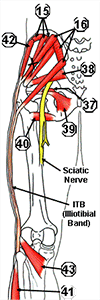 The ITB (Iliotibial Band) is a common trouble area as it contacts several nerves. It is a broad band of muscle and tendon running down the side of the leg (here seen edge-on.) It has three distinct hard cords which can be felt when pulsing across the band. Pulse it from hip to knee. The ITB (Iliotibial Band) is a common trouble area as it contacts several nerves. It is a broad band of muscle and tendon running down the side of the leg (here seen edge-on.) It has three distinct hard cords which can be felt when pulsing across the band. Pulse it from hip to knee.
Gluteus Maximus (16) has the typical pattern of a flat non-spastic center with round spastic sides and attachment line. This upper portion runs to the ITB which attaches to the lower leg bones. Pulse along the whole buttock and down and across to the outside of the leg, moving the BioPulser along the total length.
The lower portion of 16 does not appear because it is all flat and non-spastic which is lucky since it attaches to the upper leg bone after crossing over the sciatic nerve. This is one instance where a muscle serves its nerve cushioning function instead of being perverted by spasm.
The lower side of 16 forms the posterior line of the ITB and can cause pain all the way down the leg. This pain is usually misdiagnosed as sciatic even though the sciatic nerve is located more toward the center of the back of the leg. Ironically, it can trap the sciatic nerve against the Gemellus Superior to cause true sciatic pain. The upper side of 16 which forms the middle line of the ITB is more likely to cause problems where it crosses Gluteus Medius (15) (at the arrowed X) and entraps a nerve which can make walking or standing difficult. Pulse first at the X and then across the top edges of hip and along top of buttocks.
Tensor Fascia Lata (42) forms the front line of the ITB and is most often the cause of pain or numbness at or just below where it contacts the hip bone. Athletes refer to cramping there as a "hip pointer". The lower ITB makes contact with Peroneus Longus (41) & Popliteus (43). 43 crosses the back of the knee and is responsible for keeping you from bending your knees backwards. Football players, for one, traumatize this muscle by wearing cleats, which is why many of them can bend their knees back beyond straight. Pain produced by this muscle is usually felt as being behind the kneecap.
41 rides over a nerve trunk and can cause pain all the way down to the ankle, then along the side of the foot and into the toes. The tendon of 41 crosses under the foot and thus may affect all the toes.
Periformis (38) is the only muscle that doctors consider might cause nerve entrapment (if one can, why not others?), because the sciatic nerve passes under it, but 38 is innocent; it is the hard attachment line of Gemellus Superior (37) (just below 38) that entraps the sciatic nerve. Obturator Internus (39) (just below 37) may also give the sciatic nerve a little kick, but nothing compared to 37. When 39 is spastic, it is more important for blocking circulation in the pelvic floor, which it forms by attaching all along the bottom of the pelvis. Blocked circulation can lead to bladder, prostrate, uterine, and hemorrhoid problems.
One last muscle that can irritate the sciatic nerve when it develops hard spasm is Adductor Minimus (40). It only entraps the nerve when seated and leads to individuals who prefer to stand.
Pulse all indicated muscles to relieve the associated problems.
|

